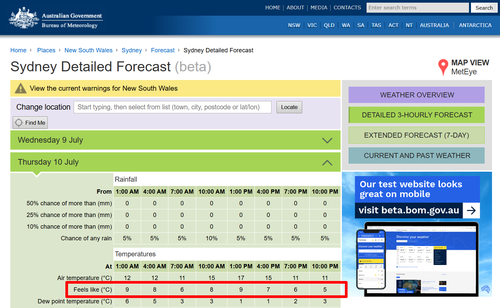Between ‘bomb cyclones’ and polar blasts, many Aussies have been shivering through what have felt like bitingly cold mornings and nights.
But what the weather feels like and what the actual temperature is don’t always align.

That’s why the Bureau of Meteorology and weather apps report a ‘feels like’ temperature alongside the usual ambient temperature readings.
Also known as the apparent temperature, the ‘feels like’ reading is supposed to reflect how warm or cool an adult would feel outdoors.
So what makes it different from the actual temperature, and can you trust it?
’Feels like’ temperature vs ambient temperature
The temperature we’re used to seeing on weather reports is the ambient temperature.
This is the temperature of the air as it is measured by meteorological instruments outside in the shade and sheltered from the wind.
But people don’t spend all their time outside in the shade and sheltered from the wind.
That’s where the ‘feels like’ or apparent temperature comes in.

This temperature represents how warm or cool an adult would feel outdoors in the shade and is calculated based on the ambient temperature, wind chill and humidity.
Wind chill can make it feel colder, while humidity makes it feel warmer.
As a result, the ‘feels like’ temperature can be higher, lower or the same as the ambient temperature.
Who calculates the ‘feels like’ temperature?
Meteorologists at the Bureau of Meteorology (BOM) calculate the ‘feels like’ temperature using a specific formula.
The equation is AT = Ta + 0.33E – 0.7WS – 4 where:
- ‘AT’ is the apparent temperature or ‘feels like’ temperature
- ‘Ta’ is the ambient temperature
- ‘E’ is the water vapour pressure, a measure of humidity
- ‘WS’ is the current wind speed
By substituting the ambient temperature, water vapour pressure and wind speed measurements into the formula, meteorologists can find the ‘feels like’ temperature.

Tourists come across extraordinary sight at Uluru
Is the ‘feels like’ temperature an official measurement?
Yes, though its official name is ’apparent temperature’.
Should I dress based on the ‘feels like’ temperature?
The ‘feels like’ temperature is based on what the weather outside will feel like to a human body, so you can usually trust it to help you decide what to wear.
That said, the ‘feels like’ temperature is calculated based on the temperature in the shade and doesn’t take the effect of direct sunlight into account.
As a result, you may feel hotter in the sun than the ‘feels like’ temperature predicts and should dress accordingly if you plan to be in direct sunlight.





